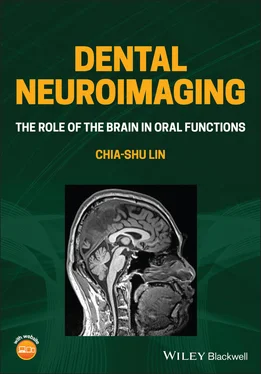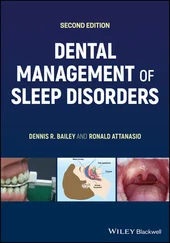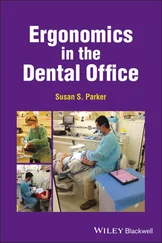Chia-shu Lin - Dental Neuroimaging
Здесь есть возможность читать онлайн «Chia-shu Lin - Dental Neuroimaging» — ознакомительный отрывок электронной книги совершенно бесплатно, а после прочтения отрывка купить полную версию. В некоторых случаях можно слушать аудио, скачать через торрент в формате fb2 и присутствует краткое содержание. Жанр: unrecognised, на английском языке. Описание произведения, (предисловие) а так же отзывы посетителей доступны на портале библиотеки ЛибКат.
- Название:Dental Neuroimaging
- Автор:
- Жанр:
- Год:неизвестен
- ISBN:нет данных
- Рейтинг книги:4 / 5. Голосов: 1
-
Избранное:Добавить в избранное
- Отзывы:
-
Ваша оценка:
- 80
- 1
- 2
- 3
- 4
- 5
Dental Neuroimaging: краткое содержание, описание и аннотация
Предлагаем к чтению аннотацию, описание, краткое содержание или предисловие (зависит от того, что написал сам автор книги «Dental Neuroimaging»). Если вы не нашли необходимую информацию о книге — напишите в комментариях, мы постараемся отыскать её.
Provides the latest neuroimaging-based evidence on the brain mechanisms of oral functions Dental Neuroimaging: The Role of the Brain in Oral Functions
Dental Neuroimaging: The Role of the Brain in Oral Functions
Dental Neuroimaging — читать онлайн ознакомительный отрывок
Ниже представлен текст книги, разбитый по страницам. Система сохранения места последней прочитанной страницы, позволяет с удобством читать онлайн бесплатно книгу «Dental Neuroimaging», без необходимости каждый раз заново искать на чём Вы остановились. Поставьте закладку, и сможете в любой момент перейти на страницу, на которой закончили чтение.
Интервал:
Закладка:
1.4.2.2 Definition of the Behavioural Scope
Another core element to be defined is our behaviour that the brain–stomatognathic connection relates to. This book focuses on human eating and feeding behaviour, which is also the primary target for dental treatment. We define feeding behaviour as ‘behavioral responses or sequences associated with eating including modes of feeding, rhythmic patterns of eating and time intervals’ (MeSH 1969). However, we will need to revisit the definitions for several considerations. Firstly, our primary concern is the feeding behaviour of healthy adults. Eating disorders, such as anorexia and bulimia, are beyond the scope of our discussion. Secondly, the stomatognathic system is critical to speech (including the production of phonemes). The issues related to speech science and language production are not discussed in this book.
1.4.3 Theoretical Frameworks of the Brain–Stomatognathic Connection
There has been literature reporting the brain–stomatognathic connection for more than 100 years. However, most studies focused on the pathological mechanisms underlying diseases, such as the infectious routes between the brain and the head‐and‐neck regions. At present, very few frameworks have been proposed for the functional perspective of the brain–stomatognathic connection. By synthesizing recent clinical and experimental findings, in this section, we try to provide a ‘big picture’ regarding the brain–stomatognathic connection ( Figure 1.3).
1.4.3.1 The Oral‐to‐Behaviour Framework
The most intuitive framework consists of the stomatognathic system as the only functional apparatus for feeding behaviour. According to the oral‐to‐behaviour (OB) framework, a sound stomatognathic apparatus directly links to good eating and feeding behaviour ( Figure 1.3a). Based on this framework, the structural and functional parameters of the stomatognathic system determine how well one can eat, such that the more teeth and the greater biting force one has, the better mastication and swallowing one will achieve. Notably, the OB framework consists of a bi‐directional relationship: while improving the stomatognathic system will help better eating, a poor eating experience will motivate individuals to fix the deficits of the stomatognathic system. Empirically, the simple logic that ‘if you have got something wrong with eating, fix your teeth first’ goes well most of the time. It echoes the traditional view that dentists are trained as a surgeon who masters the surgical work in the oral cavity.

Figure 1.3 Theoretical frameworks of the association between the brain, oral functions and behaviour. (a) The oral‐to‐behaviour (OB) framework, (b) the oral‐brain‐behaviour (OBB) framework and (c) the brain–stomatognathic axis (BSA).
1.4.3.2 Challenges from the OB Framework
However, the OB framework may not always provide a good prediction of the outcome of dental treatment. For example, temporomandibular disorders (TMD) are associated with various deficits of teeth, the temporomandibular joint and muscles. According to the OB framework, a primary step of treating TMD would be to fix the structural deficits, such as adjusting patients' occlusion by reshaping cusp morphology. However, cumulating evidence suggested that the relationship between occlusal adjustment and the improvement of patients' symptoms is controversial (Xie et al. 2013). In contrast, more evidence from the sensorimotor control of limb movement has revealed that human action is maintained by the corresponding motor program, shaped by learning and adaptation via a complex mechanism of the brain (Wolpert and Flanagan 2016). Notably, the brain would also play a major role in the stomatognathic functions since most of these functions related to feeding – either mastication or swallowing or pain, are highly associated with the integration between sensory feedback and motor commands, both mandated by the brain. Therefore, to strengthen the original OB framework, the link between the stomatognathic system and behaviour needs to be revisited.
1.4.3.3 The Oral‐Brain‐Behaviour Framework
According to the oral‐brain‐behaviour (OBB) framework, to maintain good eating ability, one needs (i) to restore structural deficits of the oral cavity/teeth and (ii) to maintain the sensorimotor control of oral functions. Traditionally, point (ii) is relatively ignored in dental treatment because dentists assume that sensorimotor processing works well. However, as shown in Chapter 7, the sensorimotor processing of the brain may alter as age increases or in patients with brain impairment (e.g. neurodegeneration or stroke). Therefore, oral dysfunctions and difficulty in feeding may be associated with deficits in brain functions ( Figure 1.3b). According to the OBB framework, for elderly or special needs patients, both fixing structural deficits and maintaining brain functions are critical to improving patients' oral health.
1.4.4 The Brain–Stomatognathic Axis
While the OBB model emphasizes that the brain is critical to the stomatognathic functions, it does not directly account for the individual differences in feeding behaviour. The OBB framework suggests that a good stomatognathic condition (e.g. fully dentated) and the integrity of sensorimotor control of oral functions both contribute to good eating ability. However, the framework simplifies the association between the brain and oral health. In addition to sensorimotor control (which has been widely investigated via animal research), mastication and swallowing are also associated with cognitive, affective and motivational processing of the brain ( Figure 1.3c). For example, as shown in Chapter 5, the tactile (e.g. ‘chewy’) and gustatory (e.g. ‘yummy’) experience from chewing is associated with an increased hedonic value and reward processing of food. Therefore, the brain–stomatognathic axis (BSA) framework highlights multiple associations between brain functions and feeding behaviour. Most importantly, the BSA framework highlights that all the functions participate in the adaptation of oral conditions. When dysfunction occurs (either due to structural deficits, aging or brain impairment), individuals also learn how to adapt to this new condition. For example, when having a meal, the patients with a new denture may keep on detecting if the denture is well fitted and judging if the food bolus is good to swallow. All the cases suggest that feeding behaviour is not a simple translation of oral sensory and motor functions. It is crucially associated with the attentional, cognitive, motivational and emotional processing related to eating.
In the BSA framework, the term ‘axis’ emphasizes a bi‐directional and dynamic relationship between the brain and the stomatognathic system (Lin 2018). In gastroenterology, the concept of ‘gut‐brain axis’ (GBA) has been proposed and widely distributed for many years. The GBA consists of ‘bidirectional communication between the central and the enteric nervous system, linking emotional and cognitive centres of the brain with peripheral intestinal functions’ (Carabotti et al. 2015). In parallel, the BSA emphasizes that the brain plays a more comprehensive role in sensorimotor and affective–cognitive processing on the stomatognathic functions and feeding behaviour.
1.4.5 How Can Neuroimaging Research Help Studying the Brain–Stomatognathic Connection?
One of the greatest advantages of neuroimaging is to explore the brain mechanisms associated with feeding behaviour directly on human subjects. For example, researchers can measure the signals related to brain activities associated with chewing and swallowing with different imaging approaches. The following sections focus on research design for investigating the brain–stomatognathic connection.
Читать дальшеИнтервал:
Закладка:
Похожие книги на «Dental Neuroimaging»
Представляем Вашему вниманию похожие книги на «Dental Neuroimaging» списком для выбора. Мы отобрали схожую по названию и смыслу литературу в надежде предоставить читателям больше вариантов отыскать новые, интересные, ещё непрочитанные произведения.
Обсуждение, отзывы о книге «Dental Neuroimaging» и просто собственные мнения читателей. Оставьте ваши комментарии, напишите, что Вы думаете о произведении, его смысле или главных героях. Укажите что конкретно понравилось, а что нет, и почему Вы так считаете.












